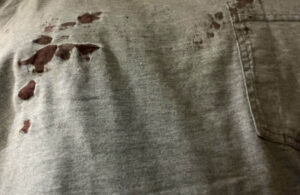I looked up just in time to see our little dog Mac’s butt and tail disappearing under a gap at the bottom of the 6-foot high wooden privacy fence.
Seconds later we heard snarling and growling. Mac yelping and screaming. We couldn’t see what was happening because of the fence, but a German Sheppard had Mac by the throat and was apparently going for the kill.
Like a flash, the neighbor whose yard Mac had invaded, ran outside. He pulled Mac out of the German Sheppard’s teeth, saving Mac’s little life.
Mac doesn’t wear a little yellow vest so he can go into the grocery store and he has no special training. But he’s definitely our family’s emotional support animal.
Mac, short for Macaroni, is a 10-pound rescue form the mean streets of Tijuana, Mexico. Our veterinarian thinks he’s a mix of poodle, terrier and maybe Yorke and chihuahua. He’s about five or six years old.
Mac’s been a part of our family for nearly four years. We are his pack.
Mac is an adventure dog. That’s not always a good thing.
Some background.
Mac went with us to dinner at a friend’s house. He’s been a visitor there many times. They have a large slope in their back yard that he likes to run around on.
A couple of years ago, Mac discovered there is a dog, a Labrador mix, that lives next door to our friends. Soon after, Mac found his way under the 6-foot fence that separated him from the Labrador mix he just had to meet. He has made several unannounced visits to meet the neighbor dog during the past couple of years. The neighbor dog apparently tolerates Mac. We’d get a call that Mac was next door (our phone number is engraved with his name on the dog tag on his collar) and have to come get him.
When he first started getting into the neighbor’s yard we couldn’t figure out how Mac was getting in. From their side of the fence it didn’t look like there were any gaps big enough. It was the same on the other side of the fence.
Everyone underestimated Mac’s dexterity and determination. He had indeed found three spots, including a stealth entrance at the top of the slope, where he could squeeze his little body through.
The evening Mac got attacked, we at first had him on a long leash tied to a tree in our friend’s backyard while we ate dinner outside a few feet away. Yes, he had his own dinner and water bowl.
Later, we decided we could let him off the leash for a while. When Mac headed for slope I didn’t think too much about it. I didn’t expect him to immediately go for the fence. My mistake.
When he slipped under the fence, Mac was expecting the Lab mix neighbor dog.
He got a surprise that nearly killed him.
Mac was immediately confronted by the German Sheppard. The dog was unknown to Mac because it belonged to the neighbor’s father, who was visiting.
After the incident, the Sheppard’s owner was in tears. Mac was bleeding profusely.
We put Mac in a bathroom sink and ran water over the wounds to assess how bad they were.
It was bad enough to trigger something that rarely happens at my stage of life: a new experience.
That new experience was the world of 24-hour walk-in emergency veterinary clinics.
At 10PM on a Saturday during a full moon, this emergency vet clinic was a happening place. All of the patients were dogs during the several hours of quality time we spent there, although the clinic does, of course, treat cats and other animals.
Mac’s bleeding had slowed. We waited about 20 minutes to get seen. The vet assessed Mac, then took him back in the back while we waited in the lobby. We heard his distinctive pain yelp coming from an examination room. A veterinary assistant came out and told us it was going to take some time to stitch his wounds and clean him up, and that we should go home and they would call us when they were done.
It was an educational evening. Did you know there are dog blood banks? That there are more dog blood types than human blood types? I do now.
At 1AM we returned to pick up our beloved little lump of hurtin’ fur. Mac was going to be OK. He had couple of big wounds and several smaller ones.
We had to watch out for infection, give him two antibiotics a day, two squirts of liquid pain medication in the morning and at night. The vertebrae in his neck were apparently fine. The Sheppard hadn’t gotten the chance to snap Mac’s neck.
The vet advised us to not have him near other dogs for a few days, and to give him some space. Don’t make too big a fuss over him. Like that would happen.
Mac was a traumatized and naturally so was his pack. Our emotional support animal needed our emotional support.
When he wouldn’t eat the bacon or cheese we presented to him, we knew he was in trouble. When he’s really depressed or thinks he’s in trouble Mac goes in the back yard and hides in bushes. A couple of times he wouldn’t voluntarily come out of the bushes so we left a bowl of water next to him until he was ready.
Drugged on gabapentin and two different antibiotics, his neck shaved down to the skin and wrapped in a tight bandage, Mac was miserable. He usually sleeps at the foot of our bed, but for the first few days after he was injured he slept between our heads on his favorite pillow. He occasionally had dog dreams where he yelped and howled in his sleep.
We were vigilant for signs of infection and went back to the clinic several times for a professional to asses his recovery and put on new bandages.
Mac has some special and somewhat unusual features for a rescue dog.
He doesn’t shed, probably thanks to his poodle DNA. He doesn’t bark. He can bark, he is capable of barking (like when he was being attacked), but usually he doesn’t. He’s not a watch dog in that regard. Someone knocks on the front door, he doesn’t sound off like many dogs. Instead, he goes to the door and waits for a human to open it so he can sniff whatever is on the other side and determine if that person has a treat for him.
He does, however, whine and moan. He was doing plenty of that during the first couple of days after being attacked.
After the attack, it was clear Mac was traumatized. He wasn’t eating. He didn’t want to go outside. Mac needed his pack’s love and support.
We kept him close. He got as many ear scratches and belly rubs as possible. Lots of extra snuggles.
He was fed his meds in balls of liverwurst. We mixed canned pumpkin and baby food into his kibble to stimulate his appetite. He received lots of hot dog chunks as treats.
It’s been more than three weeks since Mac was attacked. The bandages are off, the wounds are healing nicely. He’s back taking walks. He got to meet up with and sniff and be sniffed by two of his dog friends, Tiger, male Maltese, and Peanut, a long haired Dachshund mix. He’s wary of big dogs, which is no surprise.
Mac seems to be his loving, food-seeking self again. I’d like to think it was the intensive love and support on the part of his humans that helped him get back to being our unconditional love-giving emotional support animal.
As I write this Mac is in the backyard, engaging in one of his favorite activities: sitting in the sun.
And while I’m thinking about it, it’s time to give him a pill-free ball of Braunschweiger.








